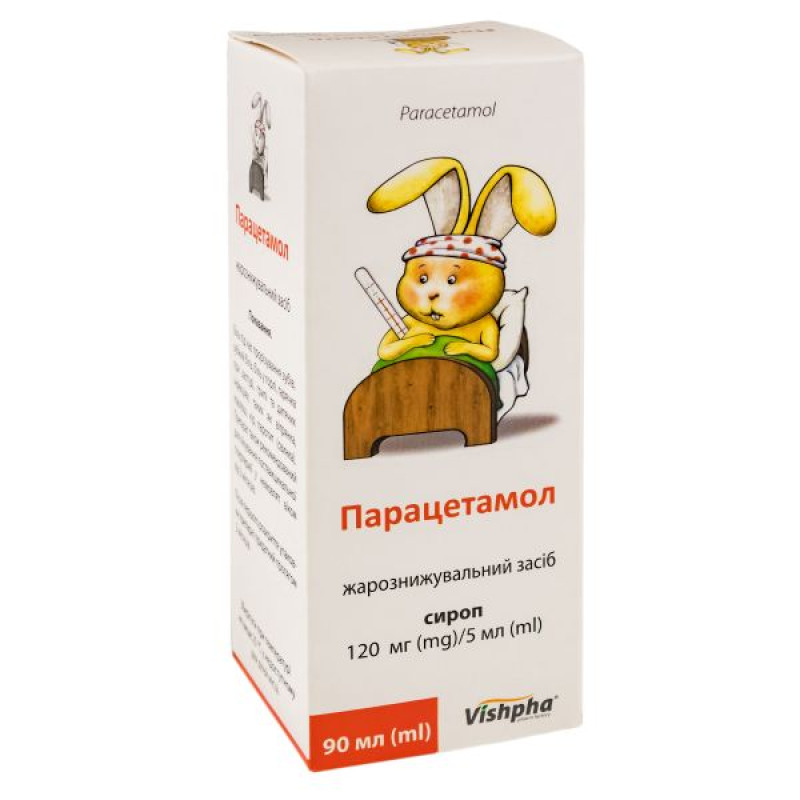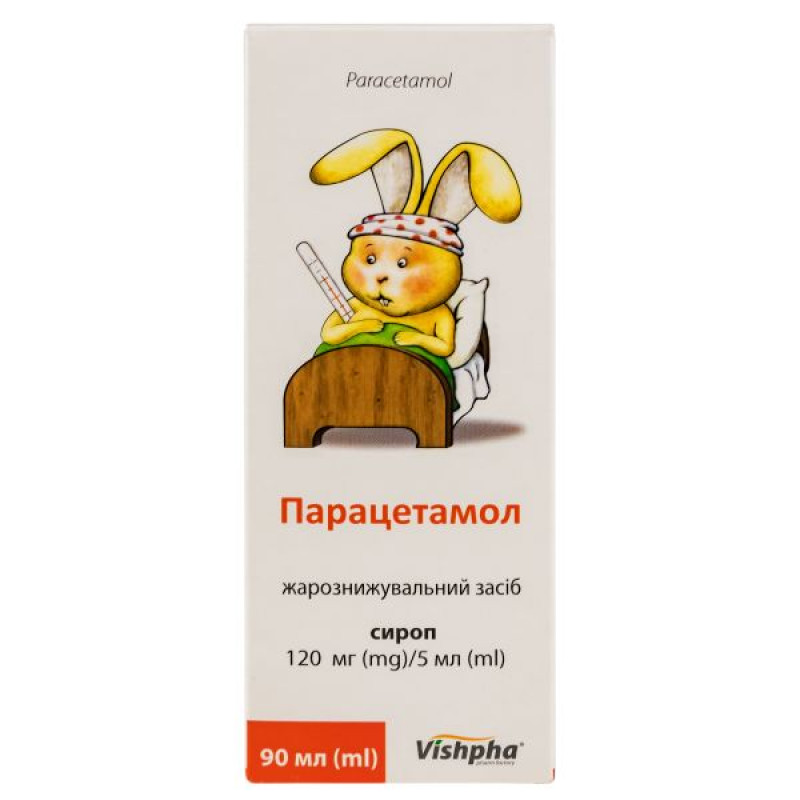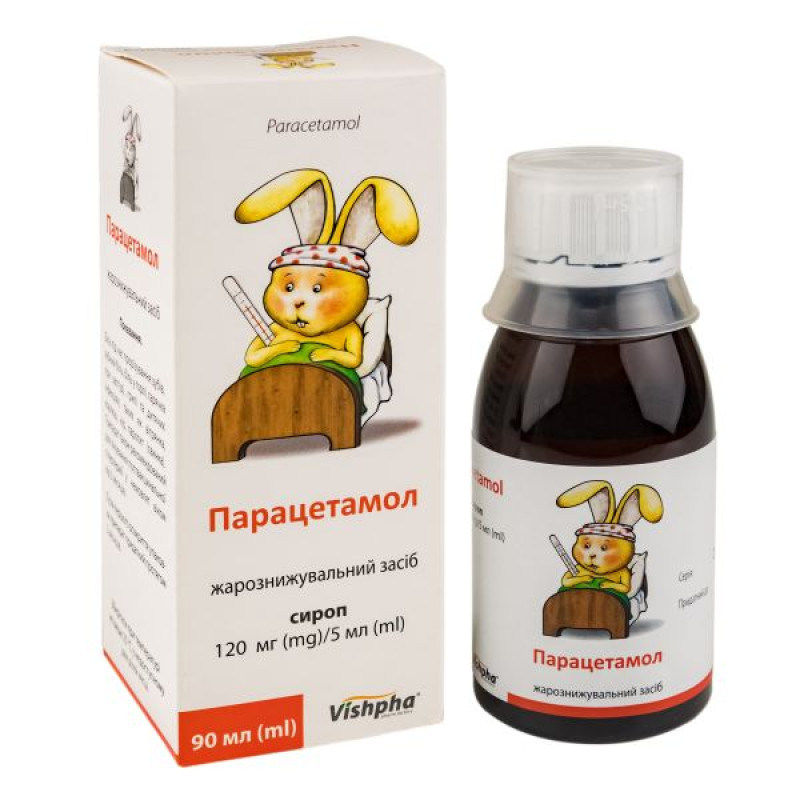Paracetamol-Vishfa syrup 120 mg/5 ml can of 90 ml

Instructions Paracetamol-Vishfa syrup 120 mg/5 ml can 90 ml
Composition
active ingredient: paracetamol;
5 ml of syrup contain 120 mg of paracetamol;
excipients: sorbitol non-crystallizing solution (E 420); glycerin, propylene glycol, sodium saccharin, potassium sorbate, aspartame (E 951), flavoring "Orange ASE 896", azo dye "Yellow West FCF" (E 110), purified water.
Dosage form
Syrup.
Main physicochemical properties: orange liquid with a characteristic orange odor, sweet taste.
Pharmacotherapeutic group
Analgesics and antipyretics. Anilides. Paracetamol. ATX code N02B E01.
Pharmacological properties
Pharmacodynamics
The drug contains paracetamol, an analgesic and antipyretic (pain reliever and antipyretic). The effect is based on the inhibition of prostaglandin synthesis in the CNS.
Pharmacokinetics
Paracetamol is rapidly and almost completely absorbed from the gastrointestinal tract and distributed to most body tissues. Binding of paracetamol to plasma proteins is minimal when administered in therapeutic concentrations.
Paracetamol is metabolized mainly in the liver and excreted in the urine as metabolites. The mean plasma half-life of paracetamol after oral administration is approximately 2.3 hours.
Indication
Teething pain, toothache, sore throat, fever from colds, flu, and childhood infections such as chickenpox, whooping cough, measles, and mumps (mumps).
The drug is also recommended for the treatment of post-vaccination hyperthermia in infants aged 3 months and older.
Contraindication
Hypersensitivity to any of the components of the drug, severe liver and/or kidney dysfunction, congenital hyperbilirubinemia, glucose-6-phosphate dehydrogenase deficiency, alcoholism, blood diseases, severe anemia, leukopenia, Gilbert's syndrome, phenylketonuria. Patients with rare hereditary fructose intolerance. Children under 3 months.
Interaction with other medicinal products and other types of interactions
The rate of absorption of paracetamol may be increased by concomitant use of metoclopramide and domperidone and decreased by cholestyramine.
The anticoagulant effect of warfarin and other coumarins with an increased risk of bleeding may be enhanced by concomitant long-term use of paracetamol. Intermittent administration has no significant effect. Barbiturates reduce the antipyretic effect of paracetamol.
Anticonvulsants (including phenytoin, barbiturates, carbamazepine), which stimulate the activity of liver microsomal enzymes, may enhance the toxic effect of paracetamol on the liver due to an increase in the degree of conversion of the drug to hepatotoxic metabolites. With the simultaneous use of paracetamol with hepatotoxic drugs, the toxic effect of the drugs on the liver increases. The simultaneous use of high doses of paracetamol with isoniazid increases the risk of developing hepatotoxic syndrome.
Paracetamol reduces the effectiveness of diuretics. Do not use simultaneously with alcohol.
High concentrations of paracetamol may affect laboratory results of blood glucose determination using the oxidase-peroxidase method and uric acid determination using the phosphotungstic acid method.
Application features
Do not use the medicine together with any other medicines containing paracetamol and used, for example, to reduce fever, treat pain, flu and cold symptoms, and insomnia. Simultaneous use with other medicines containing paracetamol may lead to overdose. Paracetamol overdose may cause liver failure, which may require a liver transplant or be fatal.
If you have liver or kidney disease or low glutathione levels, you should consult a doctor before using the medicine.
Liver dysfunction/hepatic failure has been reported in patients with reduced glutathione levels, such as those with severe wasting, anorexia, low body mass index, chronic alcoholism, or sepsis.
If the renal filtration rate is below 10 ml/min, the interval between taking the drug is increased to 8 hours.
Before using the drug, it is necessary to consult a doctor if the patient is taking warfarin or similar drugs that have an anticoagulant effect.
It should be noted that patients with liver disease are at increased risk of hepatotoxicity from paracetamol. Treatment should be discontinued if acute viral hepatitis is detected.
The drug may affect the results of laboratory tests for blood glucose and uric acid.
Patients who take analgesics every day for mild arthritis should consult a doctor.
If symptoms persist or worsen after 3 days of taking the medicine, you should consult a doctor. Before using paracetamol, you should consult a doctor if your child is taking any other medicines.
The medicine contains aspartame, which is a derivative of phenylalanine, which is dangerous for patients with phenylketonuria.
The medicine contains sorbitol. If your child has an intolerance to some sugars, contact your doctor before using Paracetamol.
The drug contains the azo dye "Yellow Sunset FCF" (E 110), which may cause allergic reactions.
Long-term use without consulting a doctor can be dangerous. Using the drug for too long or in high doses can lead to liver and kidney function disorders, as well as blood disorders.
You should seek immediate medical attention in case of overdose, even if the child feels well, due to the risk of liver damage.
Do not exceed the indicated doses.
Keep the medicine out of the sight and reach of children.
Ability to influence reaction speed when driving vehicles or other mechanisms
The drug is intended for use in children.
No effect on the reaction rate when operating machines or other mechanisms is expected.
Use during pregnancy or breastfeeding
The drug is intended for use in pediatrics.
If clinically necessary, Paracetamol can be used during pregnancy. Consult a doctor before using the medicine during pregnancy and breastfeeding.
A large amount of data on pregnant women indicate neither malformative nor feto/neonatal toxicity. Epidemiological studies on the development of the nervous system in children exposed to paracetamol in utero are inconclusive. If clinically necessary, paracetamol can be used during pregnancy, but it should be used at the lowest effective dose for the shortest possible period.
Paracetamol crosses the placental barrier and enters breast milk.
Method of administration and doses
The dose of paracetamol depends on the age of the child. Do not exceed the recommended dose. It is necessary to use the lowest dose of the drug necessary to obtain a therapeutic effect. Do not take together with other drugs containing paracetamol. The interval between doses should be at least 4 hours.
To alleviate the reaction after vaccination. Children aged 3 months to 12 years: a single dose of paracetamol is 10–15 mg/kg body weight, the maximum daily dose is 60 mg/kg body weight. If a second dose is necessary, it can be administered no earlier than 4 hours later. If the fever persists after the second dose, you should consult a doctor.
In other cases, with pain and fever. Children aged 3 months to 12 years: a single dose of paracetamol is 10–15 mg/kg of body weight. If a second dose is necessary, it can be used no earlier than 4 hours later, the maximum daily dose is 60 mg/kg of body weight. Do not take more than 4 doses within 24 hours. The maximum duration of use without consulting a doctor is 3 days.
The table provides data on the approximate dosage of the drug depending on the child's body weight and age, but in any case, you need to make sure that the dosage does not exceed 10–15 mg of paracetamol per kilogram of the child's body weight.
| Child's age | Dose (ml, syrup) | Frequency of administration per day |
| 6 months | 2.5 ml | 4 times |
| 24 months | 5 ml | 4 times |
| 2-4 years | 7.5 ml | 4 times |
| 4-8 years | 10 ml | 4 times |
| 8-10 years | 15 ml | 4 times |
| 10-12 years | 20 ml | 4 times |
For convenient dosing of syrup, the dosing cup has graduations of 2.5 ml, 5 ml, 10 ml, 15 ml, 20 ml.
Before use, shake the bottle for 10 seconds.
If the child was born prematurely, you should consult a doctor before using the drug.
If your child has kidney or liver problems, you should consult a doctor before using this medicine. This is due to the presence of paracetamol in the medicine.
Children
It is not recommended to use the medicine in children under 3 months of age.
Use for children aged 3 months to 12 years.
Overdose
Liver damage is possible in adults who have taken 10 g or more of paracetamol and in children who have taken more than 150 mg/kg of body weight. In patients with risk factors (long-term treatment with carbamazepine, phenobarbital, phenytoin, primidone, rifampicin, St. John's wort or other drugs that induce liver enzymes; regular use of excessive amounts of ethanol; glutathione cachexia (digestive disorders, cystic fibrosis, HIV infection, starvation, cachexia)), the use of 5 g or more of paracetamol may lead to liver damage.
Symptoms of overdose in the first 24 hours: pallor, nausea, vomiting, loss of appetite and abdominal pain. Glucose metabolism disorders and metabolic acidosis may occur. In severe poisoning, hepatic failure may progress to encephalopathy, hemorrhage, hypoglycemia, coma and death. Acute renal failure with acute tubular necrosis may manifest as severe lumbar pain, hematuria, proteinuria and develop even in the absence of severe liver damage. Cardiac arrhythmias and acute pancreatitis have also been reported, usually accompanied by liver dysfunction and hepatotoxicity.
With prolonged use of the drug in high doses, aplastic anemia, pancytopenia, agranulocytosis, neutropenia, leukopenia, thrombocytopenia may develop from the hematopoietic system. When taking large doses, dizziness, psychomotor agitation and disorientation may occur from the CNS; nephrotoxicity (renal colic, interstitial nephritis, capillary necrosis) may occur from the urinary system.
In case of overdose, urgent medical attention is required. The patient should be taken to hospital immediately, even if there are no early symptoms of overdose. Symptoms may be limited to nausea and vomiting or may not reflect the severity of the overdose or the risk of organ damage. Treatment with activated charcoal should be considered if the overdose of paracetamol has been taken within 1 hour. The concentration of paracetamol in the blood plasma should be measured 4 hours or later after ingestion (earlier concentrations are unreliable). Treatment with N-acetylcysteine can be used within 24 hours of paracetamol ingestion, but the maximum protective effect occurs when it is used within 8 hours of ingestion. The effectiveness of the antidote decreases abruptly after this time. If necessary, the patient should be given N-acetylcysteine intravenously according to current recommendations. In the absence of vomiting, oral methionine can be used as a suitable alternative in remote areas outside the hospital.
Adverse reactions
Adverse reactions to paracetamol occur very rarely. The frequency of adverse reactions is given according to the following classification: very common (≥1/10), common (≥1/100, <1/10), uncommon (≥1/1000, <1/100), rare (≥1/10000, <1/1000), very rare (˂1/10000), frequency unknown (cannot be estimated from the available data).
Adverse reactions
| Organ systems | Frequency | |
| Blood and lymphatic system disorders | Very rare Frequency unknown | Thrombocytopenia. Agranulocytosis, anemia, sulfhemoglobinemia and methemoglobinemia (cyanosis, shortness of breath, heart pain), hemolytic anemia, bruising or bleeding. |
| On the part of the immune system | Very rare | Anaphylaxis, hypersensitivity reactions including pruritus, skin and mucous membrane rash (usually generalized rash, erythematous rash, urticaria), angioedema (Quincke's edema), Stevens-Johnson syndrome and toxic epidermal necrolysis. |
| From the endocrine system | Frequency unknown | Hypoglycemia, up to hypoglycemic coma. |
| On the part of the digestive system | Frequency unknown | Nausea, epigastric pain. |
| From the heart | Very rare | Lowering blood pressure. |
| Respiratory, thoracic and mediastinal disorders | Very rare | Bronchospasm in patients sensitive to acetylsalicylic acid and other non-steroidal anti-inflammatory drugs. |
| Hepatobiliary system | Very rare Frequency unknown | Liver dysfunction. Increased activity of liver enzymes, usually without the development of jaundice, hepatonecrosis. |
| Renal and urinary disorders | Frequency unknown | Renal colic, aseptic pyuria. |
The drug may have a slight laxative effect.
Expiration date
3 years.
After first opening the package, the drug is suitable for 3 months.
Do not use after the expiry date stated on the packaging.
Storage conditions
Store at a temperature not exceeding 25 °C out of the reach of children.
Packaging
90 ml in a jar with a measuring cup in a pack.
Vacation category
Without a prescription.
Producer
LLC "SKP "Pharmaceutical Factory".
Location of the manufacturer and its business address
Ukraine, 12430, Zhytomyr region, Zhytomyr district, Stanyshivka village, Koroleva st., bldg. 4.
There are no reviews for this product.
There are no reviews for this product, be the first to leave your review.
No questions about this product, be the first and ask your question.








